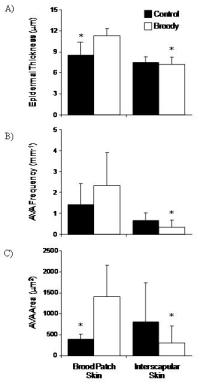
The qPCR results analyzed by the REST method showed that TRPV3 was not significantly different in the skin of brood patch for broody hens compared to non broody hens.
TRPV1 expression was very low and the results showed that the expression did not change significantly either. TRPM8 primers did not work with any of the Master mixes we tried for real time quantitative PCR.
The brood patch skin changed markedly during incubation. The epidermal thickness increased significantly in the skin of brood patch in the broody compared to non broody hens (p=0.001). The epidermis was also thicker in the skin samples of brood patch compared to the samples from inter scapular region in the incubating hens (p=0.004).
Responsible for this page:
Director of undergraduate studies Biology
Last updated:
05/18/09
